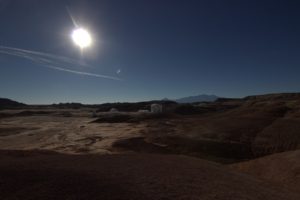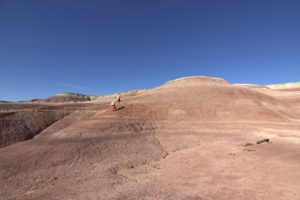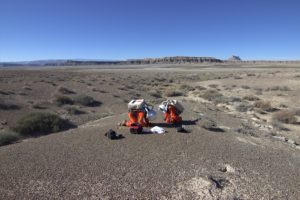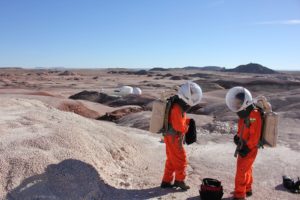EVA Narrative – November 14th
EVA Today: Challenges and Accomplishments
Another intense extra-vehicular activity!
Today, Annalea, Anastasia and I headed towards the field site at 9:17 in the morning. We decided to leave early considering the temperature outside. After gearing up, we went inside the EVA airlock and simulated depressurisation like always, and then egressed the hab. Our first task was to remove the two trash bags from hab. This EVA was basically focused on collecting hypolith abundance data by putting multiple quadrats and taking the sample back for macroscopic measurements of hypolith colonies. The first lesson learned is to always take a route map while heading for a field site. Today, although our sampling site was in the vicinity of MDRS, for the first 15 minutes we kept wondering about the most convenient way to reach to the ridge where we were supposed to put our hypolith quadrats. The ridge was approximately 1400 meters above from the sea level. Although we were trying to take a route which was most convenient and required more walking than climbing in spacesuits, to save energies for the field work itself, we ended up a shorter but difficult route. Personally, I had been to the location for an EVA previously for a different research objective but we decided not to proceed that way as it was easy but a long walk. Also, we did not have the exact route map to follow. Finally, we came to a conclusion and found our way towards the ridge. The way to reach there was shorter but absolutely tricky. We had to climb on the slippery mounds and a steep incline at the end of the ridge which, in the heavy space suit, was something to do. But we did it!
The two unexpected events happened. First, my helmet started fogging up because I was breathing fast while climbing and Anastasia found a fly (we were not alone J) inside her helmet which was very disturbing. So, we decided to stay for 10 minutes in the middle of the mound which was slippery so we adjusted our legs properly so that we do not fall down. Anastasia got rid of the fly and the fog inside my helmet started clearing up. The foggy helmet makes your excursion even more challenging and actually dangerous as you are not able to see through. So after resolving those issues we moved ahead and decided to slow down our pace which worked. During this period, we were constantly receiving transmissions from our HabCom – our Crew Geologist Dr Jon Clarke (a responsible job!). HabCom is the person who is based inside the hab, monitors the activities of the EVA team, and provides suggestions if needed via radio transmissions. This job rotates.
Finally, we reached to the sampling location. I felt that this was not the perfect site for putting the hypolith quadrats as quartz rocks were scarce and tiny in size. But I still wanted to record the hypolith abundance in this site because my ultimate objective is to cover as many places we can and in turn come up to a significant conclusion in terms of the abundance of our green friends. As we kept exploring the ridge we found a nice gravely extent to put quadrats on. And, to my excitement, we completed four quadrats and obtained significant hypolith abundance data after such difficult and exhausting ‘journey’ to the location. Moreover, I collected some soil sample for further analysis.
I was thinking why our work on recording hypolith abundance in the Utah Desert is important even though it is commonly practiced in deserts. Our work stands out because we are performing this study in full-simulation suit while carrying almost 18 kgs on our bodies. It is unprecedented and would provide a significant comparable data with other Martian analogs to understand the pattern and extent of colonization and environmental effect. Furthermore, we are testing challenges and limitations of conducting such studies in full simulation suit to obtain insights for the future human astrobiological exploration of Mars. Dr Chris McKay of NASA Ames Research Centre is the ‘Earth-based’ expert of the hypolith project. Telecommunication is a very important component of the science operations of MARS 160 mission. We have to have asynchronous communication with our ‘Earth-based’ scientists through for individual projects as sometimes protocols need to be modified according to the changing situations.
So, we finished our field work and headed back to the hab. Again, we were extremely careful while climbing down and were putting baby steps J Oh yeah, suddenly we felt that we were hungry! We started discussing the mashed potatoes (which was the menu of the lunch) on the radio. Funny!!
Figure 1. View captured on the way.
Figure 2. Climbing high.
Figure 3. Working.
Figure 4. Talk shop.







